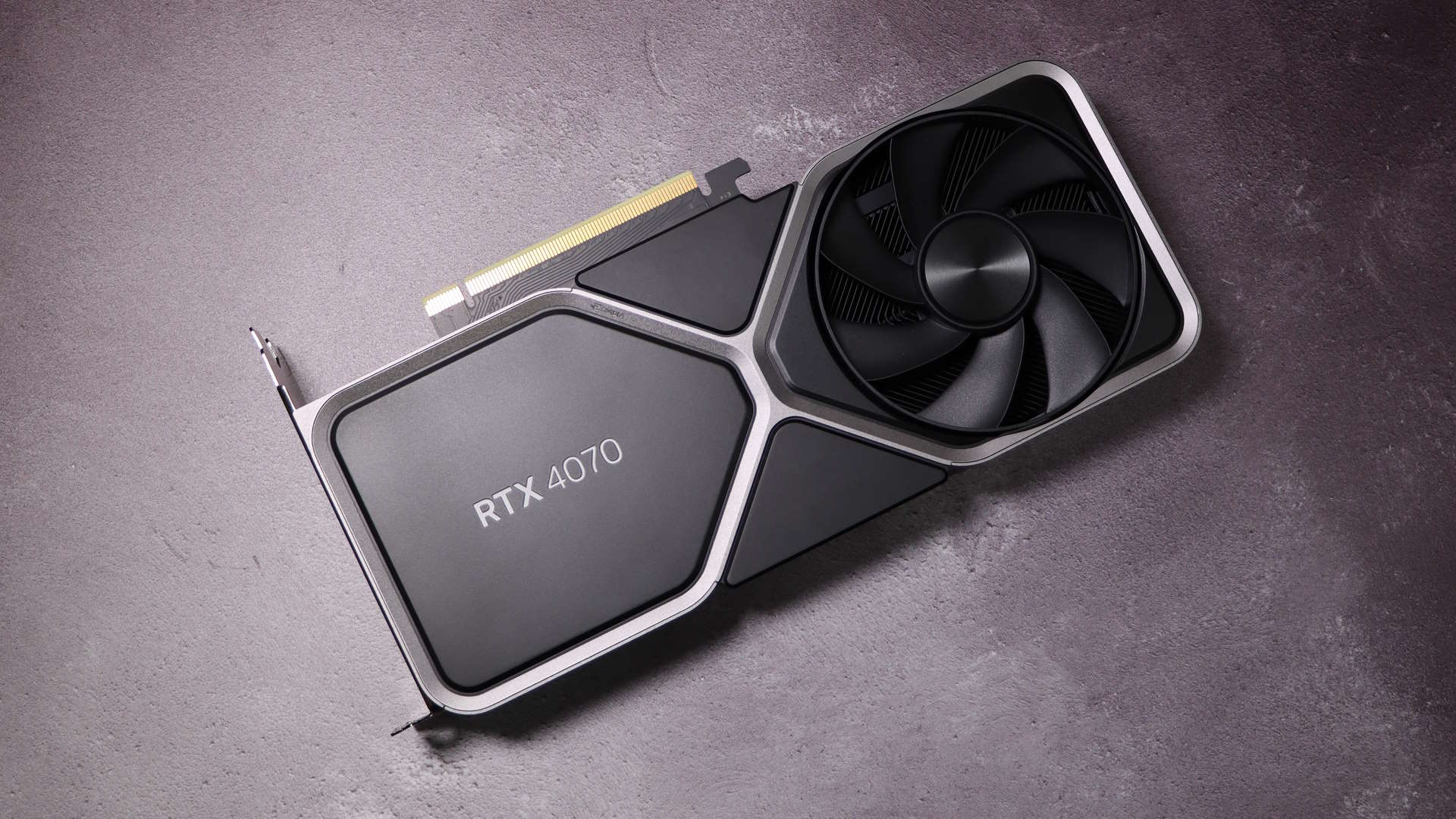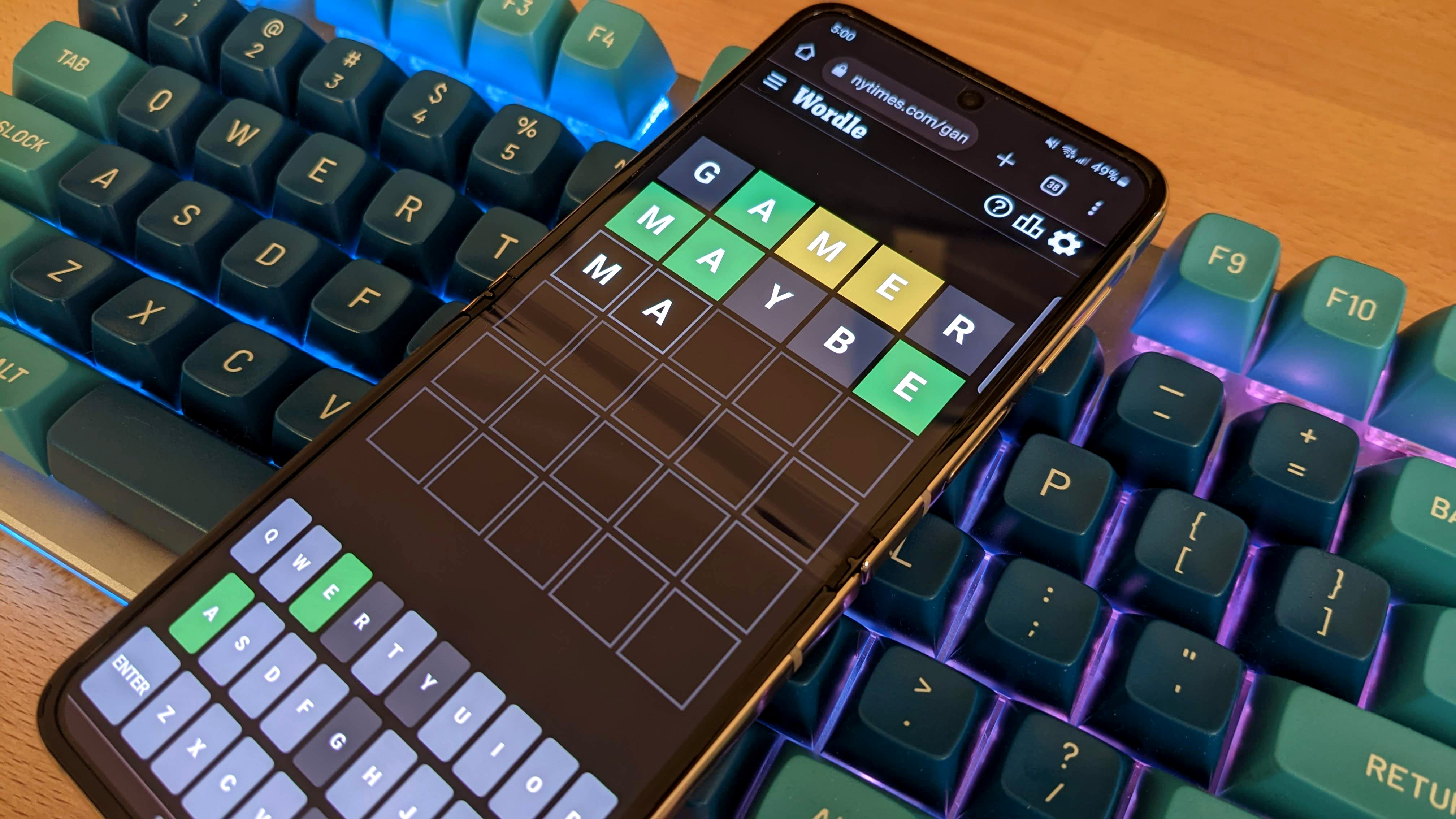
An RTX 3080 with benefits.
The Nvidia RTX 4070 is a $100 cheaper RTX 3080. That’s the easiest, but probably also the most facile, way to describe the green team’s new graphics card. This is the fourth entry in the notoriously expensive Ada generation of GPUs, and in standard metrics performs as well as the fourth tier card from the Ampere lineup. On the face of it then it’s just a cheaper chip.
But it’s not just that. The RTX 4070, this smart new Nvidia card is an RTX 3080 with benefits.
This is the first of the Ada graphics cards to utilise the same GPU as the previous release, just with a little of the good stuff cut back to create a more affordable offering. And that also means Nvidia is able to do something useful with any chip that fails to make the grade as an RTX 4070 Ti, which otherwise uses the full AD104 die, or a mobile RTX 4080.
Though the RTX 4070 is cheaper than an RTX 3080, with its $599 sticker price, Nvidia is once more raising the cost of seemingly equivalent classes of card. The RTX 3070 of the last gen came in at $499, which means realistically this new GPU is effectively replacing the similarly $599 RTX 3070 Ti. This almost inevitable shift in the price tiers takes a touch of the shine of the RTX 4070, but there are many other reasons why I’m still a fan of this new card.
Nvidia RTX 4070 verdict
(Image credit: Future)
✅ You always wanted an RTX 3080: With the same effective performance, a lower price, and DLSS 3.0 support, the RTX 4070 is a great replacement for the retiring GPU.
✅ You’re building a tiny gaming rig: The RTX 4070 is cool, quiet, and supremely efficient. It’s also a lot smaller than any other card of similar performance.
❌ You already own a decent RTX 30- or RX 6800-series GPU: At ~20% higher performance than the RTX 3070 Ti, and similar performance to the RX 6800 XT, spending another $600 so soon isn’t worth it just for Frame Generation.
The RTX 4070 is like a proper graphics card. It’s not some monstrous hulk of PCIe socket-rending GPU, it’s a modest card the size of its RTX 3070 forebear. That makes it a rather cute-looking thing. Well, in terms of scale anyways; that brushed aluminium Nvidia Founders Edition frame still looks pleasingly serious.
And that’s more than aesthetics, too. The size of the card hints at the efficiency of the 4nm Ada GPU quietly thrumming away inside of it. If you want a powerful, but low power card, the RTX 4070 fits the bill. Which will no doubt make it the darling of the small form factor PC brigade, and deservedly so.
That’s certainly one of the benefits I was alluding to earlier in the RTX 4070 vs. RTX 3080 debate, but the key one is the fact the Ada card has access to DLSS 3.0 and Frame Generation. And when that comes into play it’s a game changer, especially for titles that otherwise would struggle at ray-traced 4K settings.
The obvious drawback is that Frame Gen is not widely available. Even so, getting a $100 discount on a cooler, quieter, and far more efficient RTX 3080 has got to feel like a win when you’ve got that extra potential perf bump in the back pocket.
Nvidia RTX 4070 specs
(Image credit: Future)
What’s inside the RTX 4070?
As I mentioned at the top, this is the first RTX 40-series card to pick a pared back GPU as its base from the Ada lineup, which does put it in a different light to the Ampere generation. In the RTX 30-series you had the top-four cards all using the same basic GA102 GPU, but with varying levels of scalped graphics silicon. The RTX 4070, on the other hand, is built from the third different chip of this new Ada generation of GPU architecture.
It uses the same AD104 GPU that shipped with the RTX 4070 Ti but, where that card utilises the full chip’s 60 streaming multiprocessors (SMs), the latest spin of that GPU sports a cut down 46 SMs.
In fact, the GPU specs make it look almost identical to the RTX 3070, which itself had 46 SMs. The RTX 4070 also has the same 5,888 CUDA cores, the same 184 Tensor Cores, and 46 RT cores. The only real difference in the core config is the fact that there are notably fewer render output units (ROPs) in the newer card.
But this isn’t a straight idiomatic fruit vs. idiomatic fruit comparison here; both the new Tensor and Ray Tracing Cores are a generation further on, the newer SMs have had a tweak, and the whole thing is built on TSMC’s advanced 4nm node. That means you get a lot more efficiency out of the chip, but you can also clock the living shit out of it, too.
The RTX 40-series GPUs are generally a full 1GHz quicker than their forebears out of the box.
(Image credit: Nvidia)
The real difference maker isn’t Deep Learning Super Sampling—Ampere’s already got that down—it’s Frame Generation.
Throw in the fact Nvidia has jammed fully nine times more L2 cache into the RTX 4070 than the previous xx70 class card and you can see why those raw config numbers don’t tell the full story.
I’ve gone into greater detail about the Ada Lovelace GPU architecture before, but suffice to say it’s the clock speed and cache differences that separate the two more recent Nvidia graphics card designs.
You are still getting the 192-bit aggregated memory bus used in the RTX 4070 Ti here, and the same 12GB GDDR6X memory attached to it. That still takes some getting used to considering we were getting 256-bit memory buses all the way down to the RTX 3060 Ti in the last generation. Nvidia, however, contends that the huge rise in L2 cache means it doesn’t need such an expensive, large memory bus when it can get the necessary bandwidth without one.
Then there are the more intangible qualities the Ada architecture brings to the table. Namely DLSS 3.0, though that is a bit of a misnomer because the real difference maker isn’t Deep Learning Super Sampling—Ampere’s already got that down—it’s Frame Generation. That’s a piece of graphics wizardry that utilises Ada’s more advanced Optical Flow Accelerator hardware to create entire frames out of thin air.
Ampere has its own optical flow hardware, but not on the same scale, which is why, Nvidia says, it’s only enabling the sheer voodoo of Frame Generation on the RTX 40-series.
Sure, it’s all still based on the GPU technology itself, but is more intangible simply because it’s still software reliant—you don’t get to use Frame Generation on any game, it has to be coded in there.
Nvidia RTX 4070 performance
(Image credit: Future)
How does the RTX 4070 perform?
In the rarefied air of a $599+ graphics card, running at 1080p is a bit of a mug’s game. You can see in just how close the GPUs are in our benchmarks how much of a leveller the lower gaming resolution is. Honestly, it’s worth quickly skipping on, because if you’re intent on running at 1080p there are cheaper GPUs you can buy that will dish out excellent frame rates.
And if you’re into super high 1080p refresh rates you’re going to slashing your in-game graphics settings anyways, so you don’t need to drop $600 on a GPU.
1080p gaming performance
But there are more and more 240Hz+ gaming monitors rocking 1440p resolutions now, and it’s here that the RTX 4070 is looking really tasty. It’s also here that we do see a few tangible improvements over the standard gaming performance of an RTX 3080, too.
The RTX 4070 is then comfortably ahead of the RTX 3070 Ti it’s ostensibly the Ada upgrade of.
1440p gaming performance
At 4K it’s a little bit more varied in the RTX 4070 vs. RTX 3080 matchup, with the two cards swapping leads depending on the game. Cyberpunk 2077 aside, they’re always pretty playable frame rates.
4K gaming performance
Our testing is, however, all done without the performance benefits of upscaling in play. We’ve opted for this generation to test with ray tracing options enabled where applicable, but we’re still keen to see the native performance of the different GPUs we’re testing. But it’s still important to see what features such as DLSS, XeSS, and FSR can do to the performance of your chosen card.
After all, if you’ve got the option to use a decent upscaling option there’s almost no reason not to these days.
So, I’ve picked out a few games that have been updated to include the Frame Generation feature upgrade for DLSS 3.0, just to highlight how much of a difference that can make to your gaming experience. It shows that, while the native performance of the RTX 4070 and RTX 3080 are practically the same, in practice the actual experience could be very different.
But Frame Generation isn’t always the answer. I’ve seen for the first time, with my RTX 4070 testing in F1 22, where it’s not actually delivering. At the Quality and Balanced DLSS settings Frame Generation isn’t actually adding frames, and in fact only adds latency. It’s purely on the 4K performance setting that there’s a delta between the feature being on or off with DLSS enabled.
That’s not been the case with any other RTX 40-series GPU I’ve tested, so I wonder if there’s something happening, or not happening here with a lower spec Ada chip. It will be interesting to see if this further replicated when we see mid-range Ada GPUs.
In the other games, however, it does add extra performance, and is a definite value-add. The caveat here is obviously that not all games have DLSS, less still Frame Generation options. But modern games, especially those with ray tracing features, are starting to come around to the dark magic of interpolated AI frames.
DLSS performance
If Frame Generation can only sometimes highlight the generation gap between the RTX 4070 and RTX 3080, a quick look at the power and efficiency numbers shows what the difference looks like all the time from a systemic point of view. The 4nm Ada architecture is supremely efficient, and impressively light on power demands even when it’s topping 2.6GHz clock speeds.
With an average gaming power draw of just 197W that’s more than 100W less than an RTX 3080 running at full chat, and around 90W less than an RTX 3070 Ti, too.
System performance
Nvidia RTX 4070 analysis
(Image credit: Future)
What does the RTX 4070 mean for PC gamers?
Were we living in normal times, the idea that two and a bit years after launch you couldn’t get a fourth tier graphics card for at least $100 below its original release price would seem somewhat ludicrous. Which is I guess why I’m tempering some of my excitement over the launch of a new fourth tier graphics card with the same essential gaming performance as the previous generation’s fourth tier GPU.
Damned right we should be getting a card that performs like that for less.
And, with that, the RTX 3080 has been retired.
But there’s nowhere on this planet that you can find an RTX 3080 for $100 below its original MSRP, and coming into that situation the RTX 4070 is actually looking pretty damned good for the money. Even if you’re just looking at the standard raster performance.
We’ve long said that Nvidia must have regretted pricing the $699 RTX 3080 so low given the amounts they were changing hands for over the pandemic and mining-based chip shortages. And now we’re effectively seeing an upgraded RTX 3080 for $100 less than that price.
And, with that, the RTX 3080 has been retired. It’s finally even been removed from Nvidia’s graphics card ‘family’ list.
Throw DLSS 3.0 into the mix, with the black magic of Frame Generation, and you’ve now got a mighty tasty upgrade to what was a fantastic GPU back in the day. And for a good chunk less than you’d have been able to buy it for at any point in the past couple of years. There are a healthy number of games that have gotten the Frame Gen treatment since the RTX 40-series dropped and they’re almost all games that really benefit from that extra frame rate and extra smoothness.
On the whole you’re ending up with great 4K gaming performance on a card that otherwise wouldn’t be able to handle it. Say what you will about the venerable RTX 3080, it’s not a GPU that’s able to cope with top ray-traced settings at 4K in 2023. The RTX 4070, however, absolutely can.
(Image credit: Future)
(Image credit: Future)
It is maybe a little jarring seeing the price hike over the RTX 3070, however, but Nvidia has been at pains to suggest the new card is more a like-for-like replacement for the RTX 3070 Ti, which was itself priced the same as the RTX 4070 at launch.
On the whole, that extra 20–30% extra standard gaming performance you can get over the RTX 3070 Ti with this card makes it look like a really solid gen-on-gen upgrade, if not exactly spectacular. Again though, it’s DLSS et al that makes the newer card far more than the sum of its rasterised performance.
Where does that leave the AMD-shaped competition? It’s own bluster is based squarely around the fact that its RX 6800 XT—with ostensibly the same level of native performance as the RTX 3080—comes with 16GB of VRAM. Those cards are now around the $550 mark, making them cheaper than an RTX 4070, but they’re hotter, more thirsty, and upscaling makes the difference between 12GB and 16GB less important.
The thrust of it is that AMD needs to get on with releasing its own more affordable RDNA 3 GPUs, because I don’t feel like the last-gen Radeon is cheap enough to sway me away from the RTX 4070. Honestly, even a ~$700 RX 6950 XT wouldn’t grab me right now.
(Image credit: Future)
(Image credit: Future)
It is, however, a shame Nvidia is relying on upscaling and interpolation to push this card ahead of the old RTX 3080; I find it hard not to feel like the green team is very much holding back and playing things a little too close to the margins. Enable another couple of SMs in this spin of the AD104 GPU and you could have a card that consistently outperforms the RTX 3080 across the board.
But as upscaling becomes more prevalent, and Frame Generation gains ever more traction, the RTX 4070 is still looking like the best value Ada card around. The only potential detractor from that is the potential of AMD’s own Frame Gen-a-like technology: frame interpolation. If that is, like FSR, released as a GPU-agnostic feature, and can operate well on an RTX 3080, you could see the old card catching up to this new Ada GPU again.
Still, we loved the RTX 3080, so even if Frame Gen’s off the cards, if I can buy a cooler, cheaper, quieter, more efficient upgrade for $100 less I’m certainly in. And Nvidia has stated that it believes it’s got enough $599 cards out there—between Founders Editions and third-party reference cards—to satisfy demand at launch. A bold claim for sure, but if anybody that wants a $599 RTX 4070 can get one that will be an achievement in itself.








